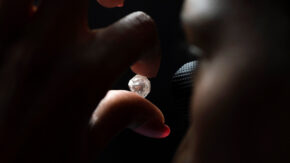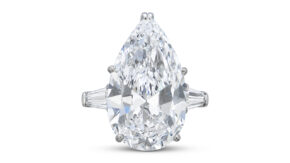In December 2015, Anglo American’s leaders informed investors of a restructuring: The mining giant would be cutting 85,000 jobs, selling some of its noncore assets, and streamlining the business into three divisions, one of which was De Beers. This put a temporary stop to speculation that Anglo could sell its famed subsidiary at the end of a challenging year for commodities, including for diamonds.
The rumors have returned. In February of this year, Anglo CEO Duncan Wanblad responded to speculation of a possible divestment by saying it was “not specifically” something the parent company was considering, according to the Financial Times. However, last week, The Wall Street Journal reported that Anglo was in the early stages of discussions about a potential sale. This came days after BHP’s $39 billion offer to buy Anglo, which Anglo rejected.
This time around, Anglo appears to be putting more serious efforts into a De Beers deal. The mining conglomerate has held conversations with potential buyers for the diamond unit in recent weeks, “including luxury houses and Gulf sovereign-wealth funds,” The Wall Street Journal said, citing unnamed sources.
The situation touches on key questions many in the industry have had in the past year: Was the 2023 slump in the diamond market another cyclical downturn or the sign of a more somber future for the industry? Have lab-grown diamonds had a permanent impact on natural?
The 2015 decline was, as De Beers’ then-CEO Philippe Mellier said at the time, an inventory problem and not purely a demand problem. The industry was suffering from structural overstock challenges.
The 2023 crisis was due to an unprecedented threat from synthetics, combined with geopolitical uncertainty, difficult economic conditions in the US, and a demand crash in China that looks pretty deep-seated.
Anglo reflected this when it wiped $1.56 billion off De Beers’ book value in February, citing a reduction in consumer demand and lower prices than previously forecast.
“Although the industry has been moving through the bottom of the cycle, we remain confident in a positive long-term outlook, and our focus at De Beers continues to be on delivering our strategy in the interests of our stakeholders,” a De Beers spokesperson said on Wednesday.
Waning power
Not that De Beers is unprofitable: Its underlying earnings have been positive in eight of the past 10 years, according to Rapaport records.
But the apparent keenness to sell — after an underlying loss of $314 million in 2023 — suggests Anglo does not see De Beers as the attractive asset it used to be.
It also reflects a sentiment that De Beers’ power over the diamond market has waned. Being a sightholder isn’t the exclusive benefit it once was.
Profitability is tight, with dealers currently seeing negative or break-even margins on resales of rough, except for a handful of 2-carat and larger items for which the miner made heavy price reductions in January. Manufacturers also struggle to profit from cutting and polishing the goods. Many see their sightholder status as a liability rather than as an asset.
Meanwhile, De Beers’ relationship with Botswana has become increasingly difficult. The sales agreement with the government was delayed and messy, and still hasn’t been signed. It left De Beers with a smaller share of Botswana’s rough and a plan to give state-owned Okavango Diamond Company (ODC) a greater proportion over time. HB has also emerged as a competitor. There’s no reason to think things will get any easier.
“The sightholder community feels less secure with De Beers than ever before,” said one of its clients in February. “Are we going to be dealing with De Beers in 10 years or directly with the governments?”
Hard sell
This raises the question of who would be interested in buying De Beers. BHP, which exited the category in 2013 with the sale of the Ekati mine, is unlikely to want a return but was cautious in its phrasing, indicating it wished to acquire De Beers before deciding what to do with it.
Anglo’s diamond business and its other “high-quality operations…would be subject to a strategic review post-completion,” BHP said in a statement outlining its offer.
Anglo and De Beers declined to comment on specifics. “We have been clear for some time that we are reviewing all the assets in our portfolio to ensure they fit for the long term,” a spokesperson for the parent company told Rapaport News on Wednesday.
The other top candidates are luxury houses such as LVMH, which, until 2017, owned half of De Beers Jewellers (known at the time as De Beers Diamond Jewellers). This would create a unique mine-to-market proposition, but companies such as this would be reluctant to take on the costs and challenges of running mines as well as the complexities of working with governments. They’d also need a strategy for selling off the huge quantities of lower- and medium-quality diamonds that are uninteresting to them.
Other options could be a management buyout, a stock-exchange listing or a sale to a financial investor.
One of the more intriguing suitors passing through the rumor mill is the government of Botswana, which already owns 15% of De Beers — though whether it could put together the billions of dollars required is another question.
Whoever buys De Beers would take on a business that sells — and therefore makes profit — in an unusual way. The company’s unique selling point is not so much its diamonds as its supply method, offering a degree of consistency and carefully created assortments in return for a premium price. This involves extremely important and potentially fragile relationships with sightholders, most of which are Indian and Jewish manufacturers and dealers working on tight margins.
All this is harder than ever given the political complexities, the rise of lab-grown, and the uncertainty in the US and China consumer markets.
“If you’ve got a couple of billion spare, would you spend it on someone like De Beers?” a market insider questioned. “It’s not a bad company, but are there less risky ways of getting access to that kind of opportunity? The answer from a lot of people would be ‘yes.’”
RELATED READING

Image: Signage at the Anglo American and De Beers offices in London. (De Beers)
Stay up to date by signing up for our diamond and jewelry industry news and analysis.



